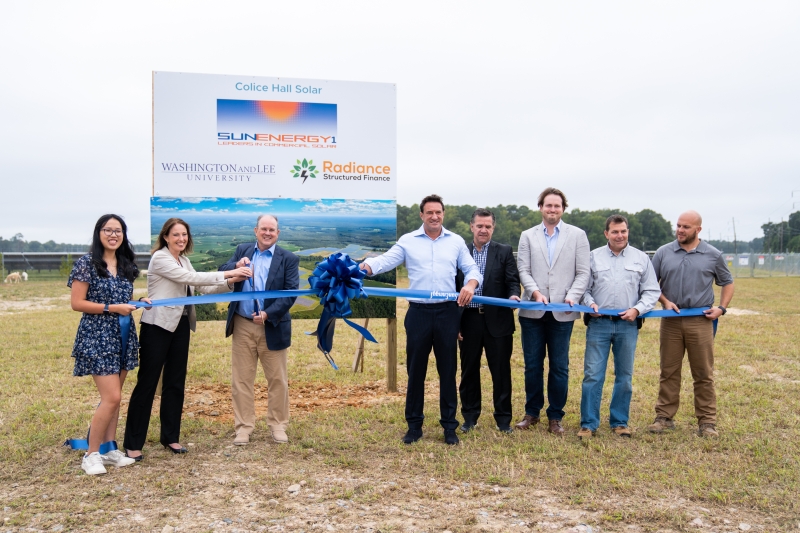Soaking Up the Sun W&L’s new offsite solar array, now fully operational, represents the university’s biggest leap to date toward an energy-independent future.
Washington and Lee officially dedicated its new offsite solar array on Thursday, Sept. 28 on the grounds of the 17-megawatt offsite solar farm, known as Colice Hall, in Hertford County, North Carolina where the array had been under construction for the past year. The site is already generating power projected to total over 22,000 megawatt hours each year for W&L under the supervision of a group of surprising site managers — a flock of sheep. The animals were just one of many sustainability considerations that were incorporated into W&L’s long-term plans for the solar array, a project that represents one of the university’s most exciting leaps forward to date in addressing its climate impact.
Last year, W&L established a partnership with solar energy developer SunEnergy1 to build, own and operate the solar farm. W&L purchases the power produced from 11 of those total megawatts, an annual total of 22,000 MWh, more than enough to match annual campus electricity use. The deal was facilitated in partnership with advisory firm COHO, a renewable energy advisor with deep experience in helping organizations develop projects that meet their goals and incorporated input and collaboration with community leaders in and surrounding Hertford.
Attendees at Thursday’s ribbon-cutting ceremony from SunEnergy1 included Kenny Habul, president & CEO of the company; Brian Kennedy, chief operating officer; Bradley Fite, president of field operations; and Rodney Woodward, field operations manager. Alex Evans ’14, a partner with Radiance Structured Finance which provided financing with the project, was also in attendance. Jane Stewart, W&L’s director of sustainability, and Steve McAlister, W&L’s treasurer and vice president for finance and administration, also invited Darby Burgett ’26, who currently serves as vice president of partnerships and outreach for W&L’s Student Environmental Action League (SEAL), to attend the event and meet with project partners.
The array is comprised of 36,000 panels spread across 230 acres. Fixed tilt panels were used in its construction, which are safer and stronger in storms – an important feature for withstanding hurricane season in eastern North Carolina. Sheep are brought in on a rotating schedule to maintain the grass around the solar panels, which creates an ideal habitat for pollinators. Dirk Corn, director of project management and procurement at SunEnergy1 and site manager for Colice Hall, said the sheep provide a self-sustaining grass and weed management plan.
“We should expect lambs in April, which allows us to double the fleet within one year,” Corn said. The company also plans to continue planting trees and grasses around the site that attract pollinators.
Jane Stewart, director of sustainability, worked closely with COHO and campus partners to establish the requirements for the project that would help the university meet its renewable energy campus.
“We didn’t want to lay claim to an existing resource, but rather to be part of creating something new that would add new capacity to the grid,” Stewart said. “Beyond the energy considerations, it was also important that the project meet broader sustainability standards. We did not want to choose a site that would require cutting down forests or that would disrupt sensitive habitats, and it was very important to us that any array we developed would be a welcome addition to the community in which it was located.” The project, which took approximately 32,000 man hours to build, was selected this year by the Association for the Advancement of Sustainability in Higher Education for its annual Sustainable Campuses Index.
W&L has three solar arrays on campus – one on the roof of Lewis Hall, one on the parking deck and a third located on the top of the student pavilion near the Duchossois Tennis Center. The university has reduced greenhouse gases from campus energy consumption by over 50%. In offsetting campus electricity use completely, the new solar array will now bring electricity-associated emissions to zero. This also presents a significant cost benefit to the university. The university’s annual utility spend is $1 million less than it was in 2007, even accounting for the expansion of the physical campus. The new solar project is expected to generate a net present value gain of $1.8 million over the next two decades, effectively setting the energy production costs for W&L’s electricity purchasing at a level currently below the market rate.
“This is the single most significant step we’ve taken as a university in terms of reducing our carbon footprint,” said Steve McAllister, W&L’s treasurer and vice president for finance and administration “and from a financial perspective, this also provides certainty in terms of the cost of electricity for the next 20 years.”
Washington and Lee University established a long-term Climate Action Plan in 2010, which was updated in 2019, and has worked steadily over the intervening years to reduce campus energy consumption, the biggest portion of the campus’s carbon footprint. The success of the solar array represents a large step by the university to significantly lower its greenhouse gas emissions, reduce long-term energy cost uncertainty, and accelerate progress to meet its goal of carbon neutrality by 2050.
 A ribbon-cutting with representatives from SunEnergy1 and Radiance Structured Finance.
A ribbon-cutting with representatives from SunEnergy1 and Radiance Structured Finance. A flock of sheep will assist with grass maintenance around the solar panels.
A flock of sheep will assist with grass maintenance around the solar panels. An aerial view of the solar panels at Colice Hall.
An aerial view of the solar panels at Colice Hall. Sheep grazing under the solar panels at Colice Hall.
Sheep grazing under the solar panels at Colice Hall.
You must be logged in to post a comment.